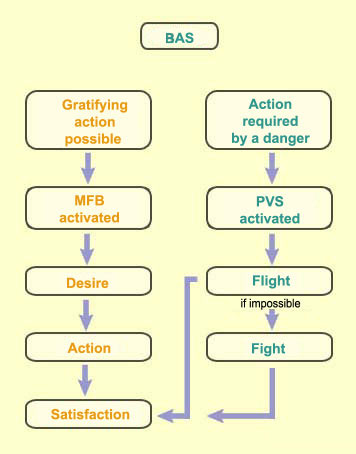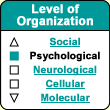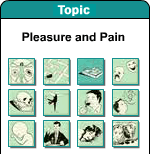| |



The
Brain and Body Are Really One, Especially When It Comes to Emotions
When an action is rewarded, the behaviour that was
the source of this satisfaction is reinforced. This is called positive reinforcement.
A classic example would be giving food to a dog as a reward for doing what you
tell it to.
Psychologists also use the term negative reinforcement
to refer to eliminating something disagreeable to encourage a particular behaviour.
A good example here would be teaching a dog to lie down by pulling downward on
its leash until it sits to relieve the pressure on its neck. | | |
| SEEKING PLEASURE AND AVOIDING PAIN | |
The brain’s primary
role is to maintain equilibrium (homeostasis) in the body’s internal environment.
The brain maintains homeostasis by instructing the body to act to correct any
imbalances as they arise. Pleasure is the mechanism
that evolution has developed to encourage us to eat, find a sexual partner, take
refuge from the cold, etc. When action is possible, pleasure is very often the
goal, through the desire-action-satisfaction cycle.
But action can also
be necessary to respond to a threat
of danger. When we are confronted with danger, we have two options: flee from
it, or render the threat inoperative. In other words, flight or fight! Whether
the danger is a hostile person or an inanimate threat such as fire, flight is
generally the first option that we consider. But if flight is impossible or would
not be effective, we try to confront the danger–in other words, to fight
the enemy or fight the flames.
 These
active approach and avoidance behaviours are under the control of what is sometimes
called the behavioural approach system (BAS). This system comprises
two main neural circuits: one corresponding to rewarded action and the other to
successful avoidance. These
active approach and avoidance behaviours are under the control of what is sometimes
called the behavioural approach system (BAS). This system comprises
two main neural circuits: one corresponding to rewarded action and the other to
successful avoidance.
The reward
circuit, or medial forebrain bundle (MFB) is activated in the desire–action–satisfaction
cycle. The punishment
circuit, or periventricular system (PVS) is activated when you decide whether
to fight or flee.
It should be mentioned in passing that the activation
of the PVS in turn activates the sympathetic
nervous system and causes ACTH and adrenaline to be released into the body
to quickly prepare it for the effort required to fight or flee.
But sometimes
neither gratifying action nor fight or flight is possible. That is when the behavioural
inhibition system comes into play.
Self-stimulation experiments on
animals are based on the positive reinforcement of an operant conditioning. In
other words, when the animal performs a certain behaviour, it receives a reward.
Similar studies on humans have shown that these stimulations of the reward bundle
produce an intense pleasure that some researchers have associated with that experienced
during orgasm. Anecdotal evidence even suggests that some of the subjects in these
experiments have developed strong feelings of attraction for the researchers in
charge. This suggests that the stimuli that reinforce a behaviour in animals are
the same kind that produce intense pleasure in humans. | |
|





 These
active approach and avoidance behaviours are under the control of what is sometimes
called the behavioural approach system (BAS). This system comprises
two main neural circuits: one corresponding to rewarded action and the other to
successful avoidance.
These
active approach and avoidance behaviours are under the control of what is sometimes
called the behavioural approach system (BAS). This system comprises
two main neural circuits: one corresponding to rewarded action and the other to
successful avoidance.